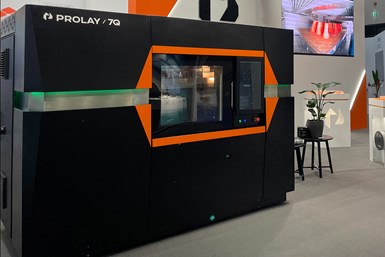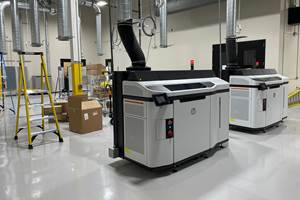Prolay 7Q 3D Offers PLTM Technology for Polymer, Composite Additive Manufacturing
The Prolay 7Q can produce components 1.5 to 5 times faster than conventional AM methods and produce parts with different layer thicknesses in a single process.
Prolay, a subsidiary of Bibus Menos, a Polish-Swiss company specializing in pneumatics, mechatronics, industrial automation and additive manufacturing (AM), has developed the Prolay 7Q industrial 3D printer.
The Prolay 7Q operates with the Progressive Layer Thickness Manufacturing (PLTM) technology, which is an advanced variant of the popular fused deposition modeling (FDM)/fused filament fabrication (FFF) method. This technology is known for its progressive layer thickness, which enables the printer to keep high-resolution surface finishes without sacrificing efficiency or durability.
Depending on the part geometry, the company says the Prolay 7Q can produce components 1.5 to 5 times faster than conventional AM methods. It can also produce parts with different layer thicknesses in a single process. The printer has a large build area of 725 × 450 × 500 mm, making it easy to produce large parts or multiple smaller ones at once.
The printer’s maximum chamber temperature reaches up to 190°C, which is crucial for processing high-temperature plastics. It features four printing heads with nozzle diameters ranging from 0.2 to 0.8 mm. The maximum temperature at which the extruder can operate is 400°C, ensuring compatibility with a wide range of commercial substances.
Layer heights range from 0.12 to 0.92 mm, giving users flexibility in balancing speed and finish quality. The Prolay system is compatible with various materials, including ABS, ABS-CF (carbon fiber-reinforced ABS), PC (polycarbonate), PC-CF (carbon fiber-reinforced polycarbonate) and PC-ABS (polycarbonate and ABS composite).
Prolay 7Q can mix up to three different materials in a single production process, which can be used to make strong composite configurations. This ability helps make thin layers of fiber-reinforced materials. For example, Prolay 7Q can print a PC shape at 0.1 layer thickness and then use carbon fiber filament inside.
Prolay is a brand of Bibus Menos, a Polish-Swiss company that started its business in Poland in 1994 as Menos. After several years, it became a part of the Bibus AG holding company, which is operating in more than 30 European and Asian countries. This strategic partnership enables the company to actively leverage over 60 years of experience and the multicultural expertise of the Bibus Group. Bibus Menos has been working in the field of 3D printing in Poland since 2005.
Prolay 7Q and PLTM technology are the results of research and development that started in 2017 as part of the project, “Development of a Faster 3D Printing Method to Reduce Production Costs and Improve Mechanical Properties while Keeping Optimum Quality.” This project was supported by the European Union through the European Regional Development Fund under the Intelligent Development Program 2014–2020.
Related Content
What Does Additive Manufacturing Readiness Look Like?
The promise of distributed manufacturing is alluring, but to get there AM first needs to master scale production. GKN Additive’s Michigan facility illustrates what the journey might look like.
Read MoreCopper, New Metal Printing Processes, Upgrades Based on Software and More from Formnext 2023: AM Radio #46
Formnext 2023 showed that additive manufacturing may be maturing, but it is certainly not stagnant. In this episode, we dive into observations around technology enhancements, new processes and materials, robots, sustainability and more trends from the show.
Read MoreQ&A With Align EVP: Why the Invisalign Manufacturer Acquired Cubicure, and the Future of Personalized Orthodontics
Align Technology produces nearly 1 million unique aligner parts per day. Its acquisition of technology supplier Cubicure in January supports demand for 3D printed tooling and direct printed orthodontic devices at mass scale.
Read More6 Trends in Additive Manufacturing Technology at IMTS 2024
3D printers are getting bigger, faster and smarter. But don’t overlook the other equipment that the AM workflow requires, nor the value of finding the right supplier.
Read MoreRead Next
Profilometry-Based Indentation Plastometry (PIP) as an Alternative to Standard Tensile Testing
UK-based Plastometrex offers a benchtop testing device utilizing PIP to quickly and easily analyze the yield strength, tensile strength and uniform elongation of samples and even printed parts. The solution is particularly useful for additive manufacturing.
Read MoreCrushable Lattices: The Lightweight Structures That Will Protect an Interplanetary Payload
NASA uses laser powder bed fusion plus chemical etching to create the lattice forms engineered to keep Mars rocks safe during a crash landing on Earth.
Read MorePostprocessing Steps and Costs for Metal 3D Printing
When your metal part is done 3D printing, you just pull it out of the machine and start using it, right? Not exactly.
Read More





















